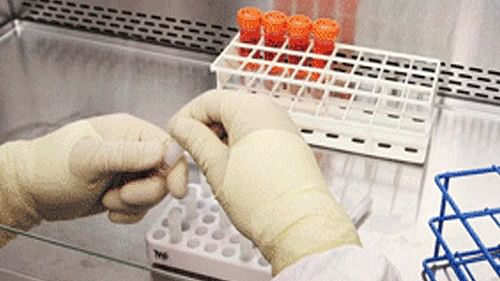
Representative Image of medicinal drug testing.
Credit: Reuters File Photo
A six-month-old boy's dark brown eyes dramatically turned deep blue after receiving a common Covid-19 treatment in Thailand, according to a case study.
The report, published in the journal Frontiers in Pediatrics, describes a case of the infant diagnosed with SARS-CoV-2 infection who was prescribed antiviral favipiravir therapy.
The researchers from Chulabhorn Royal Academy, Bangkok, Thailand said the boy was given the treatment after he developed a cough and fever -- both symptoms of Covid-19 -- and tested positive for the virus.
The infant's mother noticed a discoloration of the child's eyes within 18 hours of the therapy. However, the colour changed back to normal within five days of medication cessation.
"This case report highlights the need for monitoring of favipiravir therapy in children due to the potential side effect of corneal discoloration, which has not yet had its long-term effects identified" the authors of the study said.
In 2020, favipiravir was first used against SARS-CoV-2 in Wuhan, China, and it has also received emergency use authorisation in several countries against Covid-19.
A recent study has shown that treatment with favipiravir leads to a higher rate of viral clearance and shorter clinical improvement time in hospitalised patients, the researchers said.
However, the drug did not benefit individuals who were not hospitalised, they said.
Despite the positive results seen in hospitalised patients, there are several side effects associated with the use of favipiravir.
The researchers noted that mild hyperuricemia or elevated uric acid level in the blood, diarrhea, and neutropenia -- decrease in a type of white blood cells -- were the most frequently reported side effects, and accounted for 20 per cent of all adverse events.
Several rare adverse effects have been documented, including the bluish discoloration of the cornea, temporary visual blurring, and fluorescence of the ocular surface, they said.
However, these adverse reactions were observed to have resolved after discontinuation of the medication.
In the case of the six year old boy in Thailand, the resolution of bluish corneal discoloration was comparatively slower, according to the researchers.
Various factors, such as age, dosage, and treatment duration, may contribute to this difference, they said. The exact reason, however, for this delay remains unclear.
"This case highlights an unusual adverse effect of favipiravir therapy in the youngest known patient receiving the drug for the treatment of SARS-CoV-2 infection," the authors of the study said.
"While favipiravir is currently the mainstay of oral antiviral treatment for children with Covid-19, its safety profile in children who are still in the developmental stage is uncertain," they added.
The researchers noted that monitoring the long-term safety of favipiravir used in pediatric patients is of utmost importance.
The reported adverse event, although rare, should be taken seriously and closely monitored in future cases, they added.
Further studies are needed to determine the incidence of these adverse effect and its potential long-term consequences on corneal health, according to the researchers.